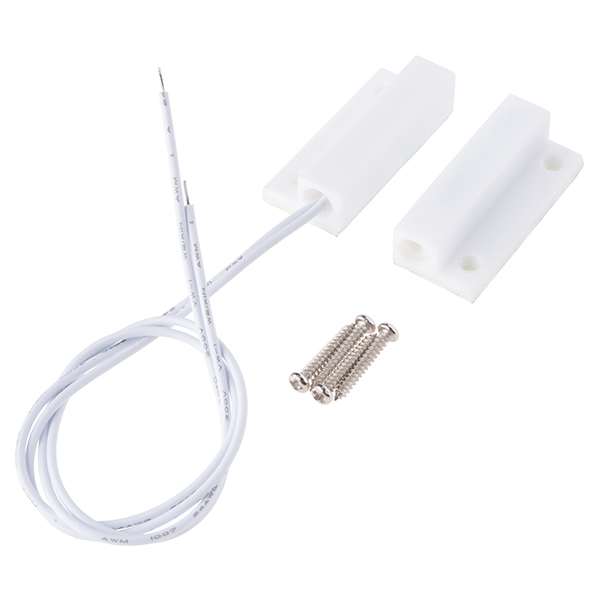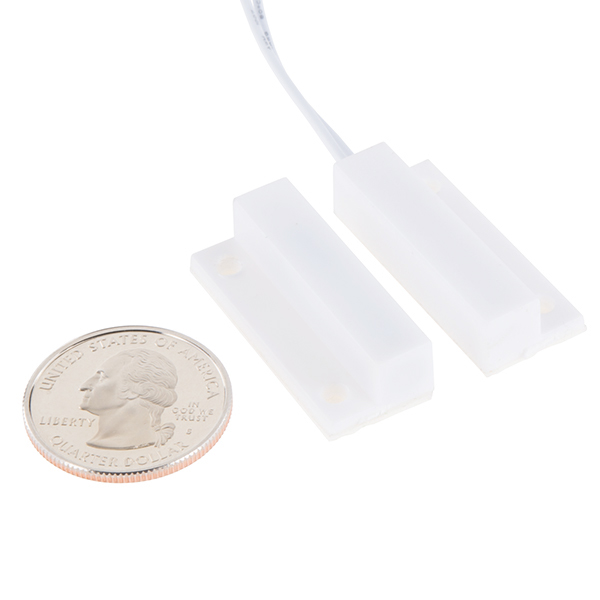This is the Magnetic Door Switch Set, a small reed switch assembly specifically designed to alert you when doors, drawers, or any other aperture opens. These types of switches are primarily used in home security systems. One half of the assembly set on a window or door frame and the other attached to the window or door itself. When the switch set is separated from each other the contact is broken and triggers an alarm.
When each magnet piece comes within 20mm of each other they complete the circuit with the internal reed switches. Each Magnetic Door Switch set can accept a max voltage of up to 100V at 500mA. Additionally each set is housed in durable ABS plastic and, with the included screws, can easily mount to most surfaces.
- 1x Magnetic Door Switch Set
- 4x Phillips Mounting Screw
- Max Voltage: ≤100VDC
- Max Current: ≤500mA
- Max Rating: ≤10W
- Gap: 20±5mm
- Contact Mode: NO
- 34 × 41 × 6.5 mm
Magnetic Door Switch Set Product Help and Resources
Button and Switch Basics
May 7, 2013
A tutorial on electronics' most overlooked and underappreciated component: the switch! Here we explain the difference between momentary and maintained switches and what all those acronyms (NO, NC, SPDT, SPST, ...) stand for.
SparkFun Inventor's Kit for Photon Experiment Guide
September 3, 2015
Dive into the world of the Internet of Things with the SparkFun Inventor's Kit for Photon.
Blynk Board Project Guide
March 25, 2016
A series of Blynk projects you can set up on the Blynk Board without ever re-programming it.
Reed Switch Hookup Guide
May 5, 2016
Magnetically-actuated reed switches are the perfect component for non-contact proximity sensors. This tutorial provides a quick overview and example hook up.
Experiment Guide for the Johnny-Five Inventor's Kit
June 28, 2016
Use the Tessel 2 and the Johnny Five Inventors kit to explore the world of JavaScript enabled hardware through 14 awesome experiments!
N.O. Vs N.C.?
This switch is normally open in the sense that with no magnet present, the contacts are open. When a magnet is nearby, the contacts close.
Core Skill: DIY
Whether it's for assembling a kit, hacking an enclosure, or creating your own parts; the DIY skill is all about knowing how to use tools and the techniques associated with them.
Skill Level: Noob - Basic assembly is required. You may need to provide your own basic tools like a screwdriver, hammer or scissors. Power tools or custom parts are not required. Instructions will be included and easy to follow. Sewing may be required, but only with included patterns.
See all skill levels
Core Skill: Electrical Prototyping
If it requires power, you need to know how much, what all the pins do, and how to hook it up. You may need to reference datasheets, schematics, and know the ins and outs of electronics.
Skill Level: Rookie - You may be required to know a bit more about the component, such as orientation, or how to hook it up, in addition to power requirements. You will need to understand polarized components.
See all skill levels
Comments
Looking for answers to technical questions?
We welcome your comments and suggestions below. However, if you are looking for solutions to technical questions please see our Technical Assistance page.
Customer Reviews
No reviews yet.





Are these things waterproof? Would one continue to work even if submerged a few inches in water?
I got one that is 22 AWG previously and it worked fine, now I got one that is 24 AWG and it does not work for my project (the magnet needs to be closer). I am trying to catch a magnet about 10mm away. Are they supposed to be the same part? Can I buy another with 22 AWG wires?
Based on the product pictures and invoices on this part, it looks like they have always been 24AWG. Are you sure you got those (22AWG ones) from us?
That being said... the distance between the magnet and switch should be minimal in normal operation; as that is their intended use and how the manufacturer quality checks the parts. The distance between the magnet and the reed switch is based on the magnet's strength... therefore, you could always use a stronger magnet for your use case.
Otherwise, if you are looking for technical assistance, please use the link, in the banner above, to get started with posting a topic in our forums. Our technical support team will do their best to assist you.
can i use this switch to light up the LED in cabinets. When i open the cabinet door will it turn the light on?
It depends on the voltage and current that your LED is using since there is a max rating. As stated in the features tab:
I'd probably use it with a transistor to toggle the LEDs (assuming that it is a non-addressable LED strip).
Commanded 5 for a closet application because they are advertised as NO (Normally Open). I wanted to power a LED stipe when the door opens. I assumed that was Normally Open with the magnet beside ! But I was wrong. This switch is closed when magnet is beside it. Sounds more like NC to me !
In the electronics world NO means that a device in a non-activated (resting) mode is Normally Open. When the device is activated, in this case when the Magnet and the Reed Switch comes in contact, that normally open switch closes.
What you are looking for is a NC switch, that stays open as long as the door is closed, and once the door opens and the switch goes back to it's rest position of "Normally Closed" the lights activate.
Are these polarized?
Does this require any resistors being hooked powered to an arduino 5v?
Strange way to word things "Each Magnetic Door Switch set can accept a max voltage of up to 100V at 500mA"
I guess maybe I'm just nitpicking but it's not really "at 500mA" but rather "up to 100V, and up to 500mA"
Oh, as I made this sentence I realized it's not particularly easy to state "Max Voltage 100V. Max current 500mA" in a comfortable sentence. But the distinction between these being two different ratings that operate independently, is what I was getting at.
Also, 100V DC? That's pretty high- cool.
It would be nice to clarify if the NO contact mode is with the magnets influence present or not??
So it appears that this is a "normally open" switch. Anyone happen to have a link to the data sheet for this switch? I need to know the temperature range this switch can operate at. A garage in Phoenix can get pretty hot during the summer. Don't want it to melt.
just a few days after I ordered the inferior reed switches :( :P
Regarding the contact, I see NO/NC. Is it NO or NC? I need a contact that close when I open the door for a different application than an alarm system.
Looks like they updated the product description to "NO". Guess that means "Normally Open".